Study background
The climatic conditions of the Canadian arctic region have been hard to comprehend over the years owing to the frequent changes experienced and great variations. The climatic situation varies from one region to another; even in cases where the climatic conditions tend to be similar, the flora and fauna varies greatly.
In its original state, climate of the Canadian arctic can be described as complex owing to the fact that it is not easy to forecast. In fact, numerous weather stations have been established in the area in the attempt to capture the climatic patterns. From the findings at different weather stations in the area, the conclusion is that the climatic conditions in the Canadian arctic are unpredictable. The unpredictability has largely been compounded by climate change.
However, apart from findings from the weather stations described above, no comprehensive study has ever been done to determine the overall climate change trends in the area. Moreover, there are plant and animals species in this region that are still adapting to these climatic changes.
There is need for research to determine how the plants are adapting to changing climatic conditions. Since relocating the plants and animals has never been a solution, as the effects of climate change are felt throughout the region, there is need to consider how the plant and animal species will survive.
Problem statement
The rapid change in the climatic conditions that are being experienced in the Canadian arctic is the result of an increase in the level of the natural calamities such as the fire incidents, flora disease outbreaks and pest infestations. The same is true of all other ecosystems i.e. due to certain human activities and other natural causes, climate conditions are changing.
Talking of the Canadian arctic, “The region has experienced an increase in concentration in the carbon dioxide level and that has led to an increase in the ultra violet radiations, which have an adverse and long term effect in the plant and animal life hence causing an alteration in the whole ecosystem” (Abbott & Brochmann, 2003).
This further brings about a reduction in the nutrient cycle and creates a potential for the decrease in the in the level of ecological productivity hence a decrease in the number of the ecological factors.
This problem needs being addressed starting with the question of how to save flora and fauna in the area. The climate has been changing and there is need to establish how animal and plant species are adapting. It is critical to study changes in flora and fauna in the area so as identify trends that would help in designing intervention measures.
Literature review
Maxwell (1997) addresses the issue of the current climatic change in the Canadian arctic in relation to the past trends and concludes that there is a dramatic change that may be traumatic in the near future. These are threatening to the ecosystem and they may end up rendering the region a dessert. Callaghan et al (1999) allege that most of the plants and animals species that had adapted to the wet conditions may end up being extinct.
Some of these species include the lichens, mosses, the herbivorous animals as well as their predators. Callaghan et al (1999) further explain, “The Biodiversity is more at risk in some of the regions such as the Beringia regions than in others” (244). The population make up is also changing at an alarming rate and this is prompted by the climatic trends and the occurrence of the tremendous events such as the extensive winter seasons followed by an abnormally warm season.
According to Abbott and Brochman (2003), the most likely result of these abnormal weather conditions is the replacement of the Tundra vegetation with forest cover hence leading to a complete change in the species that have been in existence in the region for a long time. The forests however may not be able to advance to some locations owing to some environmental factors and the sociological processes taking place in these regions (244).
Some of the effects that may come up owing to the reduction in the tundra vegetation and the expansion of the forest cover is the reduction in the level of the ratio of the reflected light to the incident light. This is a positive effect owing to the fact that it increases the level of the positive feedback in the carbon cycle when compared to the negative cycle. This is most likely to result in an increase in temperatures hence eliminating the ice from the sea surrounding the region.
Recent research conducted in the region suggests that there has been an increase in the level of warmth experienced in the region as well as a lot of drying of the soil cover. “This has been felt more in the Alaska region where it has also been observed that the carbon status has been changing from the original sink to source. Some of the areas still have a strong sink concentration but the regions that have experienced the change are more and still increasing in number ” (Chapin et al, 1995).
The uncertainties experienced in these regions as far as the climatic conditions are concerned are likely to result in change in the composition of the soil supporting the tundra vegetation. The soil composition is moving from a high concentration of sink carbon to low concentration and in the long term, it is anticipated that this will lead to a displacement in the current vegetation cover.
Scope
This study is aimed at establishing the elements in the Canadian arctic that have resulted from the climatic changes experienced over the years. This region is usually described as the “treeless wilderness with cold winters and cool summers” (Chernov & Matveyeva, 1997). The focus is on the effects of these climatic changes on the animals, plants and microorganisms and the events that come because of these changes.
A good example of this is the migration of the animals to the southern region during winter. These changes however have no effect on the geographical developments being studied in the area. It only shifts the interests of the researchers from the existing tundra vegetation cover to the developing forest cover.
It has been discovered that the dominant vegetation cover in the southern arctic region is the circumboreal forests while the northern, which is the Canadian region, is still highly dominated by the tundra vegetation. The transition area between these two is however moving towards the northern direction indicating that the tundra vegetation is becoming extinct and is being replaced slowly with the forests.
According to Callaghan et al (1999), this transition region is often referred to as the sub arctic region, the ecotone, forest tundra, or the tundra – taiga boundary (244). One of the most outstanding characteristic of the vegetation cover in this region is that it grows in an open landscape and it has a combination of trees and shrubs hence creating a ground cover for the soil surface.
The Arctic Circle is located at 66.50 and it is a region that does not have political definition. The main climatic determinants in this region are the low angles in the position of the sun in relation to the earth.
Maxwell (1997) asserts that great differences have been observed in the photoperiod between summer and winter but his are extreme towards the northern area. “Beyond the arctic circle the sun remains above the horizon at midnight on the midsummer’s day and remains below the horizon at midday on the midwinter’s day” (Jonasson et al, 1999).
The climatic conditions in this region are characterized by temperatures ranging from 100C at the warmest point to as low as -28.10C in winter. The average temperatures in a year however vary according to the locations irrespective of the position along the latitude. The level of precipitation is generally low especially in the inland regions and this goes on to decrease as one moves further away from the water bodies.
Despite this, it is not possible for these areas to develop the arid conditions since they are characterized by low rates of evaporation. The polar desserts have high levels of humidity in the air and the soil is humid as well. The term dessert therefore refers to the poor weather conditions and not the dry conditions like in the other regions of the world.
According to research findings recorded by Abbott and Brochmann (2003) “there are around 1800 different species of plants, 4000 species of cryptogams, 75 species of terrestrial mammals, 240 species of terrestrial birds, 3000 species of fungi, 3300 species of insects and thousands of prokaryotic species” (65).
The diagram below is an illustration of the evolution of the biological processes in the Canadian arctic region that has been happening over the years.
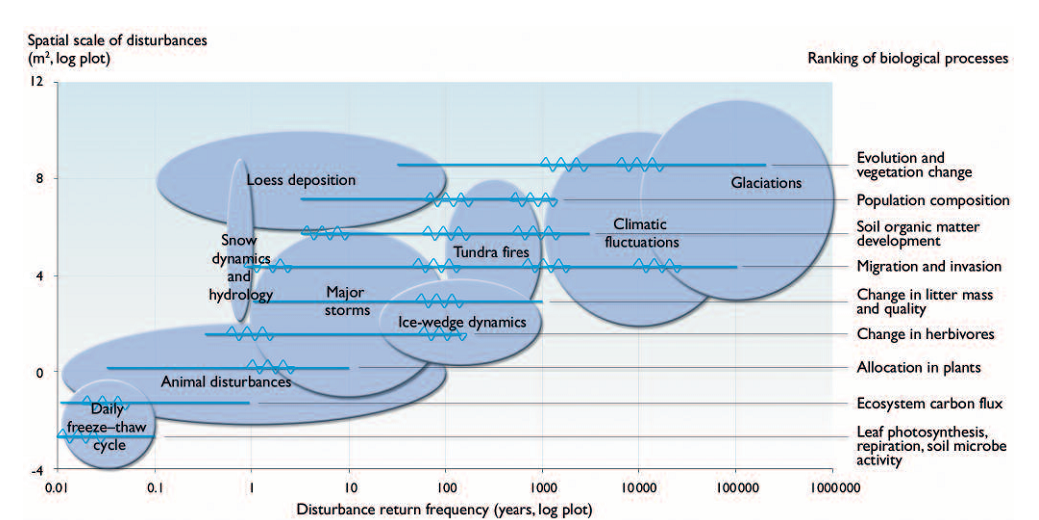
Note: ACIA. (2004) The Timescale of environmental processes in comparison to the climatic disturbances.
Summary
The main idea behind this study is the establishment of the climatic factors that have led to the development of the current vegetation cover in the Canadian arctic region. The vegetation has been evolving over the years and most of the researches that have been conducted based on this have never been fruitful in drawing valid conclusions.
This is so because of the rapid evolution in climatic conditions being experienced in the region over the years. Several stations have been set up in different places to try to capture the climatic patterns but this has never been successful owing to the frequent variations. It is therefore not possible to determine the future climatic conditions in this area because of the unpredictability of the patterns.
Introduction
Climate change is of key concern to all well-meaning citizens of the world. Kaplan et al (2003) states “Climate change is a serious, urgent and compelling issue”. The arctic and other Polar Regions are critical to human survival as they hold over 70% of world’s fresh water reserves.
Climate change is real because the whole world has in the recent passed witnessed unpredictable climatic conditions. Due to weather unpredictability, economic activities like farming cannot be properly timed and desertification is on the rise. In places like Africa, if climate change continued there is likely to be increased droughts and famines.
However, not just the tropics that are adversely affected by climate change. As Kaplan et al (2003) note “climate change have far reaching implications for global growth, social, human and economic development, environmental sustainability, governance, peace and security, and on sustainable development as a whole”. The Canadian arctic is not safe from the effects of climate change. Of special interest is how the plant and animal species in the arctic are adopting to changing climatic conditions.
Drastic changes in the climate have drastic changes on the species of animals and plants inhabiting different regions in the world. Kaplan et al (2003) acknowledge the fact that climate change unless mitigated is likely to make the vulnerable and disadvantaged groups even more marginalized and disadvantaged. This is also true of marginal species of flora and fauna found in the Canadian arctic and other areas in the world.
This paper will consider the flora and fauna of the Canadian arctic. The key focus will be on how the vegetation in the Canadian arctic has been adopting itself to changing climatic conditions. Equally important will be discussion on how human intervention can help the flora and fauna in the arctic either adapt or be spared of climate change effects. The bulk of the paper considers research on the same i.e. findings by different researchers into state of flora and fauna in the Canadian arctic.
Characteristics of vegetation cover in the arctic region
The Canadian arctic is characterized by the presence of the boreal forest cover, which over the years has been replacing the original tundra vegetation. The forests extend widely towards the northern direction with the south still under the cover of the Tundra vegetation.
There is a transition point between these two regions consisting of a combination of the tundra vegetation and forests organized in a sequence, which is closed forest on the northern side of the transition point, a combination of the forest and tundra, and towards the south plain tundra vegetation cover.
This region ranges between 30km to 150km and this is a very narrow region when compared to the extent of the entire vegetation cover in the region. “Superimposed on the latitudinal zonation of the forest and the tundra is an altitudinal zonation from the forests to the treeless areas to barren ground in some mountainous regions of the northern taiga” (Kaplan et al, 2003).
The transition point between the tundra vegetation and the forests is considered one of the most important transitional features in the world and it has been an attraction to many geographical researchers over the years. The area has high temperatures compared to the parts of the region though this narrows down to the lowest temperatures as one moves towards the center. This climatic inconsistency explains why it is an attraction to many people.
It has been referred by different people in different terms some of which include “forest tundra, sub arctic, tundra – taiga boundary or the ecotone” (Maxwell, 1997). The low physique shrubs and the intense thickets in addition to the tree covers form a dense ground cover that appears like an open field from the bird’s eye view.
Another major characteristic of this area is the continuous alteration of the ecosystem. This is mainly caused by the “mechanical disturbances brought about by thermokarst, which is mostly induced by the permafrost thaw and freeze thaw processes such as the wind, sand and ice blasts” (Neilson & Drapek, 1998).
Besides these, Callaghan et al (1999) states that other features that have led to the environmental disturbance in this area are “seasonal ice oscillations, slope processes, snow load, flooding during thawing changes in the volume of the rivers and the erosion and flooding of the coastal region”.
Some of the ecological disturbances experienced include outbreak of pests and diseases, increase in the number of the grazing animals and frequent fire outbreaks. These alter the composition of the whole ecosystem especially when the original ecosystem is eliminated and a new one is being developed. The distribution of the vegetation cover in this region is illustrated in figure 2 below.
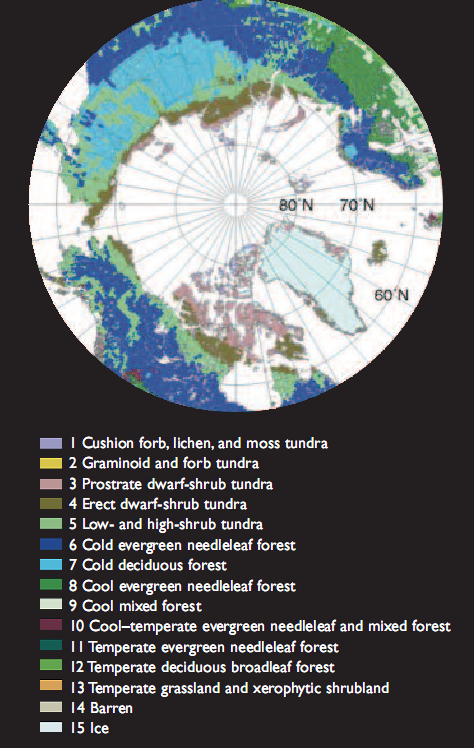
Note: (ACIA, 2003). the current vegetation cover in the Canadian arctic classified according to the types of vegetation.
From the diagram above, it can be noted that the vegetation cover in this region is made up of the forest – tundra cover dominating the southern region. The northern region is made up of polar deserts, which have been extending over the years. Here, the vegetation covers only 5% of the entire ground and it majorly consists of the plants that do grow more than 19cm high. These include the mosses, lichens, herbs and algae. The food chains in this region are brief ones owing to the existence of a few numbers of representatives in the chain.
Human and Ecological history in the Canadian arctic
Few studies have been conducted on the ecological history of the Canadian arctic region. The most recent one however indicated that their rate of ice decay is increasing over the years hence creating a “lag between the global changes and the ecological changes owing to the regional influence of the ice sheets” (Robinson et al, 1998). Initially, the ecological changes experienced in this area seemed to be because of geographical location and the picture portrayed here was an illustration of widespread vegetation replacement.
The poplar deserts were a common feature in most of the areas that were not entirely covered by the ice. With time, the tundra vegetation started coming up and replacing the polar desserts. Much later, the woodlands started developing too owing to the climatic changes that favored their existence. The later is still developing with time and gradually replacing the tundra vegetation that has been dominating the region over the years.
The most recent 10,000 years were characterized by high temperature summers in the northern altitudes and this explains the rapid development of the forest cover. These conditions made it possible for the trees to grow and extend towards the northern side where the intensity of light was higher.
The winter season was not very intense and was characterized by high precipitation, which however did not last for a long time. Owing to the increasing temperatures, the sea level started to rise and this was the result of the melting ice in the sea. The animals’ species that existed in the tundra vegetation were stressed by the changing climate and they began to go into extinction either by migrating or by dying. New species of animals came in to existence and during this period, the Canadian arctic became a very productive landscape.
The first inhabitants in the arctic region were the ancient hunters and gatherers who existed in this region over 40,000 years ago. At that time, they never lived in the northern area owing to the high glacial capacity but with the coming up of global warming that resulted into deglaciation, the northern land became capable of supporting human life.
These people survived by hunting wildlife using sophisticated handmade tools. The population started to increase as the climatic conditions created more land for settlement. It is argued that their hunting activities are what led to the extinction of most of the vertebrate animals in this region, though this has never been established with certainty.
The most valid argument, however, is that these animals went into extinction owing to the environmental changes that led to the reduction of the biotic community in which they existed. human activities contributed much to this and so the most probable conclusion could be that they contributed a great part to the extinction of these animals, though they were not the main factors that led to this.
Anticipated changes in relation to the trends observed in the late quaternary
The table below is an illustration of the recent vegetation cover trends that have been observed in the last quarter of a century and the forecasted future trends based on this observation.
From this table, it can be noted that the future of the Canadian arctic ecosystem is endangered. The first indication in this is the fact that the changes in climate in the coming century can be compared to the magnitude of the changes that have been experienced from the period when there was full glaciations to the current period.
These changes are happening at a faster rate compared to what has been experienced in the past 10,000 years. Second, “the universal increase in the mean annual temperature is projected to occur at rates that are higher than the rate of global temperature increase during the last deglaciation” (Walker, 2000).
In the Canadian section of the arctic, the rate of increase in warmth is moving towards the direction of the conditions that have been recorded in the past quaternary. This rise in temperatures leads to an increase in the volume of the sea, hence a rise in the sea level and so the tundra vegetation that was favored by the cool temperatures becomes scarce. These predicted future conditions in the arctic are most likely to result in to negative effects being experienced in the Canadian arctic ecosystem and the biota.
Table 1: Comparison between the main projected environmental changes and the changes experienced in the late quaternary.

Note: Data adapted from “Spatial and temporal variability in the responses of Arctic terrestrial ecosystems to environmental change” (1999).
Implications of the current species distributions for future biotic change
Plants diversity
Research conducted on global vegetation indicates that approximately 3% of the universal plant species are found in the Canadian arctic. Abbott and Brochmann indicate that of this 3%, 0.7% consists of the angiosperms, 1.6% the gymnosperms, 6.6% the bryophytes and 11% the lichens. Other species besides these in the region are the cryptograms, which includes the liverworts, algae and mosses. This information on the population that makes up the ecosystem of the Canadian arctic is summarized in the table below.
Table 2: Biodiversity of the species richness estimates in the Canadian arctic.
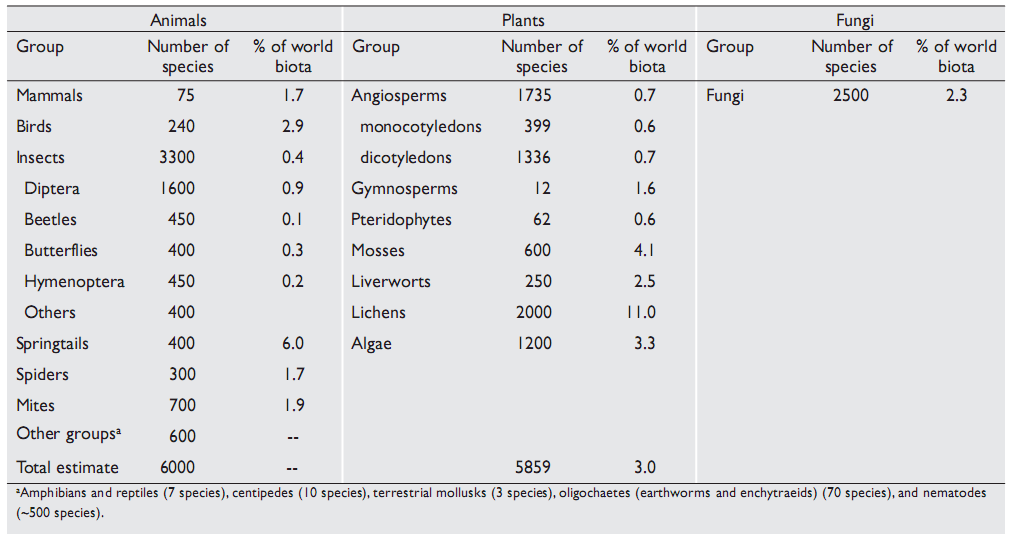
Note: Data adapted from “Spatial and temporal variability in the responses of Arctic terrestrial ecosystems to environmental change” (1999)
The diversity of the ecosystem in this area is highly reactive to the climatic changes. It has been noted that the changes in temperature experienced in the recent past have led to a drastic change in the population of the plants species.
Researchers also discovered that the regions lying along different latitudes might have temperature conditions that resemble yet they have different ecological species. This is referred to as the latitudinal gradient of species diversity and is illustrated in the graph below using the example of the ground beetle species.
This graph shows the distribution of these species in relation to the climatic changes. It illustrates the relationship between average temperature changes in the selected month and the population of the ground beetle species existing in the geographical location.
Further research indicates that the variation in the population of these species is less frequent towards the southern arctic, meaning that the northern part of the arctic is the most affected by the changes in temperature. In cases where the steep latitudinal changes in temperature are experienced the species of plants tend to vary at a higher rate compared to where the latitudinal changes are less steep. Different species also react differently to the changes in climate.
Different species of plants and animals respond differently to the climatic changes. This is because some of them thrive well in warm temperatures and hence they migrate when the temperatures are low while others do well in cold temperatures and so they become scarce in a warm climate.
This explains why the vegetation and the animal populations in the Canadian arctic vary with altitudinal as well as the latitudinal differences. Despite the fact that temperature is one of the factors that responsible for the current state of the ecosystem in this area, it is not the only one. The reproduction of most species depends highly on the intensity of light and so the length of the day light plays a major in the increase or extinction of most of these species.
It has been observed that the diversity of species making up the ecology in the Canadian arctic is low. “It seems that most of these species largely exist in the boreal forests and they decrease as one moves from the forested land to the polar deserts” (Van Wijk et al, 2004). Mosses and lichens dominate the largest percentage of this population owing to their high level of adaptability capacity to climatic changes.
The global warming being experienced in this region however may eventually lead to an increase in the diversity of the plants and the animals species. Some of the initial species may become extinct but this will favor the development of many other species hence increase the biodiversity together with the length of the food chain.
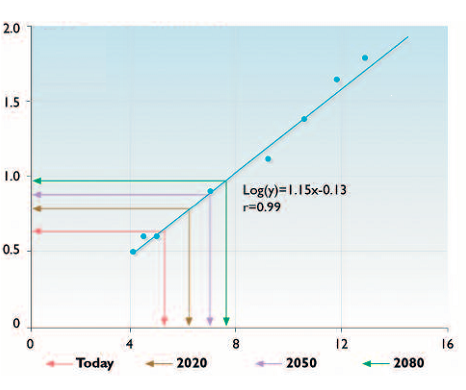
Note: Jonasson et al (1999). Responses in microbes and plants to changed temperature, nutrient and light regimes in the Arctic.
Structure of the ecosystem
The general conclusion on the ecosystem of the Canadian arctic is that the area has a shortage of vegetation. The region is characterized by a wide variation in the structure of the ecosystem diversity. According to Chernov and Matveyeva (1997) “the typical communities for a specific latitude are referred to as zonal while the local variation at the landscape level occurs and these intrazonal communities are frequently associated with the variations in the moisture of the soil together with snow accumulation” (34;78).
The region that contains both the tundra and the forest vegetation cover consists of a combination of shrubs and the short trees though growing sparsely.
The northern part of this region consists of strictly tundra vegetation made up of plants species that do not grow beyond 10cm.The Northern region of the Canadian arctic largely consists of the polar deserts and supports a very low population of plants species. Some of the species that exist in this region includes the cryptogram, the cushion plant and plants in the mire community.
Further north, species of plants tend to become scarcer and the main vegetation cover is the herbal cryptogram. In this area, the highest temperature in summer has never gone beyond 20 C. precipitation is the dominant climatic feature in this area and this is in the form of snow.
Researchers in this area have further divided the tundra region in to three different sub regions and this includes “the southern tundra consisting of shrub – sedge, tussock shrub and the mire community. The typical tundra on the other hand consists of the sedge – dwarf shrubs and the polygonal mire communities and finally is the northern tundra which mainly consists of the dwarf shrub – herb communities” ( Neilson & Drapek, 1998).
Further north, the land is largely pre occupied with the polar desserts and hence vegetation becomes more and more scarce. Kaplan et al (2003) argues that the classification of vegetation has geographical implications and it may not be possible to apply this knowledge in the restoration of the vegetation that existed earlier on in the region (83). Kaplan et al (2003) came up with tabulated illustrations of the tundra biological classification as shown below.
Table 3: Circumpolar arctic biome classification.
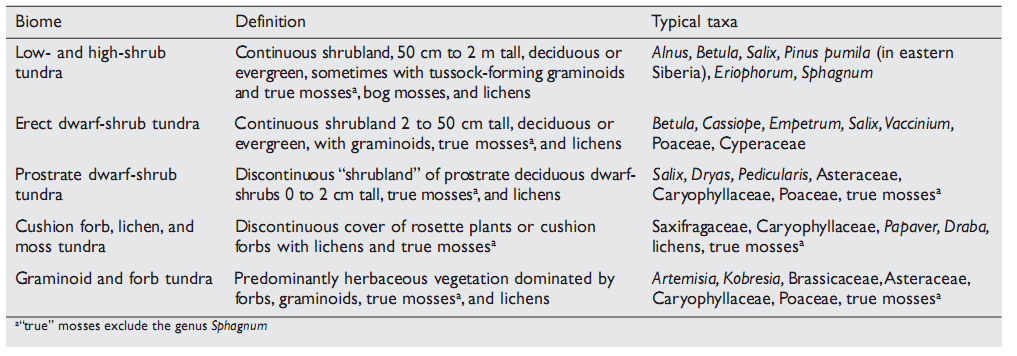
Note: Data adapted from “Hierarchical subdivision of Arctic tundra based on vegetation response to climate, parent material and topography” (2000)
Amongst the zonal vegetation, there exist the intrazonal ones mainly characterized by the great variations in the moisture content in soil as well as the accumulation of the snow. This region has a climatic condition that is different from the general climatic conditions observed in the flat surface regions. “The areas that have poor drainage are mostly dominated by the sedges with a scarce population of mosses and liverworts” (Van Wijk et al, 2004).
Despite the fact that each of the intrazonal regions are characterized by few plant species, these regions when put together contain a wide variety of species compared to the zonal regions put together. The intrazonal regions carry more than 80% of the total number of species in the Canadian arctic’s plants’ and animals’ population.
These regions are also characterized by naturally formed landscape mosaics such as the one shown in Figure 4 below. This landscape was formed by the action of freeze and thaw cycles together with the frequent thermokarst trends. Other natural features that have occurred as a result of this include focal points and oases, and these features have enriched this landscape such that many different species can coexist.
Examples of these species according to Walker (2000) include the “dense willow thickets, that are two meters in height and they mainly thrive in the sheltered valleys at a latitude of 750 N. it has been observed that these species tend to respond more positively to high temperatures ” (156). A large proportion of this land is dominated by moss and that particular portion of the landscape appears as shown in figure 5 below.
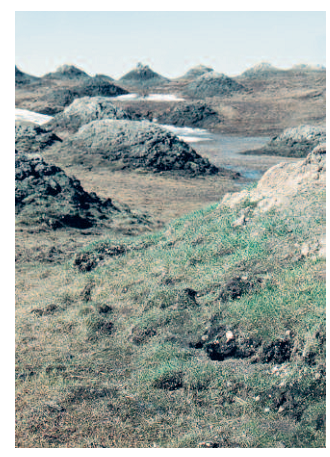
Note: Callaghan et al (1999) Spatial and temporal variability in the responses of Arctic terrestrial ecosystems to environmental change.
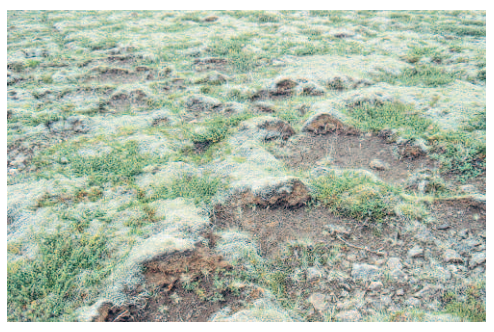
Note: Callaghan et al (1999) Spatial and temporal variability in the responses of Arctic terrestrial ecosystems to environmental change.
Further on the structure of the ecosystem in the arctic region are the vertical and horizontal structures. The vertical structure is more dominant in the lower region of the Canadian arctic and according to Chernov and Matveyeva (1997), this region is characterized by a “well developed shrub canopy and an understory of mosses, similar to the vertical structure in the boreal forests” (156).
This vertical structure can also be defined from the characteristics observed below the ground surface. Lichens and mosses for example do not have a well-defined root structure, while some other species of plants have roots that develop in the layer of moss. Very few species have real roots going deep into the ground and this could be because of the weak soil surface that cannot be in a position to support strong well-defined roots.
Plant communities
Jonasson et al (2001) came up with the idea that the addition of nutrients in the soil surface is the environmental factor that has the greatest effect on the productivity of the ground, the height of the plants and the composition of the plant community (245).
“The amount of fertilization in the soil also plays a major role in the determination of the biomass turnover rate, so eventually biomass may or may not change in response to the addition of nutrients. This is illustrated in the diagrams below, which indicate the total vascular plant biomass that has been observed over a period.
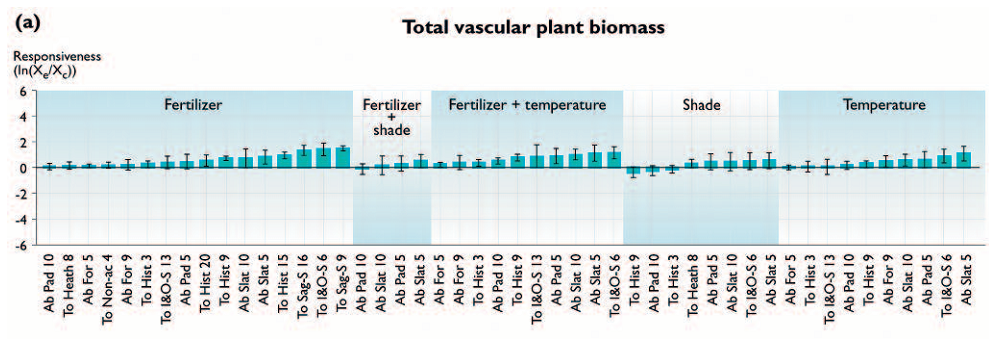
Van wijk et al (2004). Long-term ecosystem level experiments

Van wijk et al (2004). Long-term ecosystem level experiments
These diagrams indicate various factors considered to have led to an increase in biomass in this region. The first one is the level of fertilization in the soil and this is said to have contributed to the high nutrients level in the soil. The existence of the mosses is also believed to have contributed a large extent to the high levels of fertilizer in this region. Besides this, the other nutrients that are found in this region include phosphorus and nitrogen.
This is believed to have resulted from the existence of the microorganisms in the soil whose action has often led to the increase in these nutrients in the soil. It however feared that this might not last long owing to the fact that these microorganisms are being displaced gradually with the development of the forest vegetation.
In the past however, an artificial method of fertilizer addition was developed and this largely included the introducing the microorganisms in the soils manually or creating an environment that encourages their survival. The following graph illustrates the results that were observed after this exercise.
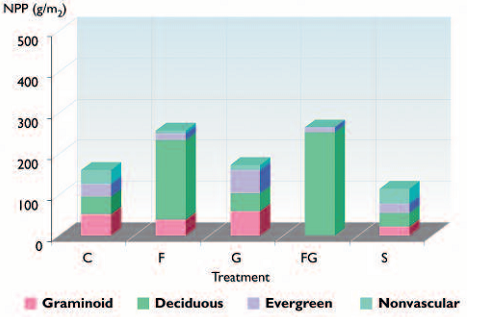
Note: Chapin et al (1995): Responses of Arctic tundra to experimental and observed changes in climate
“Where C stands for the controlled observations, F the annual nitrogen and phosphorus fertilizer additions, G the cases where temperatures have been controlled during the growing season, FG where the fertilizer has been induced and the temperatures controlled as well and S is where there is an artificial reduction in the intensity of light in the growing season” (Chapin et al, 1995).
In some of regions, it was observed that the addition of nutrients in the soil resulted in to a decrease in the number of vascular plants. This was as a result of the augmented winterkill effect which despite of this still stimulated the development of the mosses as the ground cover for the region.
This observation was made by Robinson et al (1998) who went ahead and explained another effect that was the opposite of what he observed in the lower part of the Canadian arctic. The difference he explained was as a result of the movement of the mosses that produce nitrogen from the lower Canadian arctic region to the higher altitudes.
Animal communities
Temperature changes experienced in the Canadian arctic have been observed to affect the animal population on the ground surface compared to the underground organisms. This can be because the soil surface shelters these underground organisms from the temperature changes being experienced in the atmosphere.
It was also observed that the animal species with a short life cycle such as the Collembola species were in a position to respond more quickly to the changes in temperature compared to the ones with long life cycles such as the mites. Most of these species never existed in the time when the ground was covered by snow. The changes in temperature have therefore favored their growth and this is also what determines whether they will be in a position to survive or are headed towards extinction.
In the recent years, it has been recorded that there is a growing number of animals since the temperatures in the area started to go up. Many species of birds have been breeding and increasing in number owing to the favorable temperatures. It is however difficult to determine the exact population size since the animals keep migrating between the northern part of the region and the southern.
The number of birds has however been estimated to some hundreds of millions and the species observed in the region mostly include the divers, waders and geese species. These animals tend to decrease in number as the latitude decreases and this can be blamed to the changes in temperature accompanying the change in latitude.
Herbivorous animals survive better in this land owing to the fact that they mainly depend on vegetation for food. Such include fox, raven, and the ermine and these are an important part of the forestland in the Canadian arctic. Compared to the plant species, animals are considered more diverse owing to the fact that most of them relate well to warm temperatures.
With plants, it is the opposite since they tend to become extinct with the increase in temperatures. Researchers have also discovered that most of these animals are highly concentrated in areas where their food plants are growing. This means that their population changes in relation to change in vegetation.
Adaptations of different species to changes in climatic conditions
Studies conducted in the recent years on the adaptations of plants to the climatic conditions of the Canadian arctic has been more concerned with the characteristics that enable these plants to survive the harsh climatic conditions in this area. Another lie of research has however been developed where they are expected to study the possibility of these plants to withstand the changing climatic conditions.
The former adaptations were considered advantageous but this recent study revealed that they had the capacity of constraining their existence in the warm climatic conditions. This is due to the competition that they would be facing from the plants that come up because of the change in temperature, since the latter would be more accustomed to the climatic conditions.
One of the former adaptations of the arctic plants that could make it difficult for them to thrive in warm temperatures is the ability to withstand frozen conditions. This makes them adversely vulnerable to the warm climate since this condition is the contrary of what they are used to. Another adaptation is their slow development which most of the time is as a result of the low temperatures.
The change in temperatures therefore might tend to increase the rate of growth in these plants hence causing a disturbance in the normal trend that could result in to reduced ability to compete for resources from the soil. These climatic changes bring about an evolution in the distribution of the plant and animal species and they may end up forming a completely different pattern of distribution hence completely altering the current ecosystem.
The animals that have been in this region for a long time are also naturally adapted to the cool temperatures. “Physiological studies have contributed to the mechanistic understanding of how the animals in the Canadian arctic have been able to cope with the extreme climatic conditions especially the low temperatures” (Jonasson et al, 1999).
These animals have grown to adapt to the frequent changes in temperature hence ensuring that their species has been able to survive through the years. This favored by the fact that the changes in temperatures occur gradually leaving enough time for the animals to adapt to the new conditions.
Pre determined responses to future changes in temperature
Abbot and Brochmann (2003) suggest that the “changes in temperature being experienced in the Canadian arctic region is most likely to affect the growth, development and reproduction in most of the arctic plants especially the ones that have a high phenotypic plasticity” (Walker, 2000). Temperature is however not the only factor that affects this plants.
Others that play a major role in this include the nutrients level in soil, moisture content and competition from the species that are coming up due to the warm climatic conditions. Some of the negative responses of the indigenous plants to the increase in temperatures include, first the increase in respiration in relation to photosynthesis, which might result in imbalance in the content of carbon in the environment.
Secondly, increase in temperature results in thermal death brought about by evapo-transpiration occurring in the warm temperatures, third is the total extinction of the plants that are used to wet habitats because of the exposure to high temperatures and finally is the slowed rate of growth to the species whose development was favored by the low temperatures.
Unlike the plant species, it has been difficult to determine the future trend in the population of the animal species. It has however been observed that the greatest effects of change in climate have been observed in the population of the terrestrial animals such as the rein deer. These animals are mostly affected by the changes in the vegetation cover than by the climatic changes owing to the fact that they are warm blooded hence have the capacity to adjust accordingly to the changes in temperatures.
These animals have been surviving on the tundra vegetation cover and since this has been gradually changing to the forest vegetation, it becomes difficult for them to continue existing in the region. With time, therefore they may end up becoming extinct either by migrating or by not being in a position to reproduce in the current climatic conditions.
Institutional Interventions
Economically, climate change unless mitigated is likely to cause huge economic losses and slow economic growth in many countries. Across the globe, many people rely on agriculture, which is the mainstay of especially third world economies.
If the peasants in those countries do not harvest enough food from the farms, food shortage is inevitable leading to extreme suffering. Lack of food security means those governments of countries spending available resources on people’s survival; as opposed to improving service delivery and building socio-economic infrastructure necessary for economic growth.
Food shortage is a very critical element in impoverishing nations. Nations that prosper have assured food supply and thus the population can focus on other developmental matters like education and industrialization. Apart from affecting agriculture, climate change affects tourism and even fishing industry. Through unpredictable weather, many would be tourists are discouraged from visiting coast resorts.
The arctic region would suffer greatly if climate change continued unabated. Indubitably, the vegetation and animals would disappear due to ice melting and washing them away but also due to changes in ecosystem. Therefore, it is imperative to find ways of mitigating the same for the good of the whole world.
Not all is lost and there is still room to correct and avert dire climate change. Climate change, on the other side, is an awakening call that can lead to more efforts that will lead to sustainable development.
Some of the efforts would include effectively engaging the international community so that arctic region issues and concerns are clearly articulated and incorporated in the International climate change management framework. it may be helpful to form an international coordination body that looks into efforts to avert bad climate change effects in the polar regions.
Other initiative would involve setting up a special fund to facilitate research on fauna and flora in the arctic. It is through research that real issues, related to flora and fauna in the arctic, can be unearthed leading to informed decisions. Research is not enough unless it informs policy. Therefore, there is need to establish a policy centre that focuses on Polar Regions.
Finances may be the biggest headache when it comes to conservation and preservation efforts in the arctic. The problem of climate change is humongous, which means that resource available that can be committed to environmental management; especially mitigating climate change effects are minimal and can never be enough.
Therefore, bodies interested in the conservation and preservation of flora and fauna in the arctic need find mechanisms through which it can attract funding and properly manage the same towards realization of desire results.
Management of resources is very critical and thus brings to the fore the challenge of governance and leadership. There have been many cases, across the globe, of lead agencies in conservation and preservation initiatives squandering or misusing funds (Cramer and Matveyeva, 2003).
Largely, many of these lead agencies tend to be accountable to themselves. Therefore, to avoid suspicion, when it comes to use of resources meant for preservation or conservation of flora, fauna in the arctic, public debate and probing has to be encouraged. Unless governance and leadership of conservation initiatives are improved, proper and articulate responses to climate change will remain elusive.
Governance or proper management of public goods is only achieved when participation is encouraged. Participation is very critical because all people have to be brought on board when it comes to sustainable development or environmental management. Everyone has to be brought on boards because each individual activity has externalities.
Climate change poses great challenges to the world but also great opportunities. Due to the threats posed by climate change, an opportunity has presented itself for the world to shift paradigms. Due to collective response to climate change, this is an opportunity for countries to integrate their policy thus forge one common way forward. Challenges have always existed in environmental management due to countries not being ready to cooperate.
However, with the imminent dangers, countries are jolted into action and thus it is easier to realize consensus. Faced with environmental threats such as climate change, most countries are now ready to engage others in negotiations. Such efforts come from the realization that cooperation is more beneficial and more effective than otherwise. For long countries resisted cooperation due to fearing cost implications of engaging in environmental management.
Further, countries tended towards the perception that some countries would benefit more from environmental management efforts than themselves. However, as environmental economists have demonstrated, the cost of environmental management is lower when countries cooperate rather than when they go it alone. Secondly, the marginal national damage to the environment reduces with cooperation.
The propensity towards consensus in the world, due to realization in terms of how grave climate change is, should provide propulsion for conservationists. Climate change initiatives by bodies like UN are a great opportunity to rally other countries towards measures that would avert climate change. Environmental problems cannot be handled in isolation i.e. consensus and full participation of all on the globe is critical.
Conclusion
The Canadian arctic like all other parts of the world has not been spared from the throes of climate change. As researches by different researchers and institutions have shown, there are gradual changes in climatic conditions in the Canadian arctic. What is clear from the researches is that weather conditions have become more sporadic and unpredictable.
A key feature in the weather changes is increased atmospheric temperatures. Increase in temperatures has acute effects on the region as it melts the ice and affects photosynthesis of plants in the region.
The changes in the climatic conditions being experienced in the Canadian arctic have many positive as well as negative effects on the entire ecosystem in the region. In as much as we need to appreciate the positive effects, the negative effects on plant and animal life are catastrophic and annihilating in the end.
Research shows that both the plant and animal’ species in the region are in danger. In as much as there are direct effects of climate change on animal species, so far, it has been deduced that adverse effects on the animal’ species result from the effects experienced by the plants’ species.
This is not surprising owing to the fact that the animals depend directly on the plants for food. Therefore, any changes in or the extinction of the former depends directly on the extinction of the latter. It is necessary that efforts are undertaken to maintain biodiversity in the region.
There are two key causes of problems in the region i.e. soil composition and increasing temperatures. High temperatures either cause direct thermal death to plants or alter the biodiversity in the area due to melting ice. The changes in the area, caused by increase in temperature, affect the plants in a big way.
Animals rely on plants for survival and thus any effect in plant life is transferred to the animals. Some species of plants seem to thrive well in the warm temperatures hence outgrowing the indigenous species that was favored by the cool and freezing climatic conditions. In as much as this is encouraging, there is real danger of the indigenous plant species becoming extinct.
Considering that climate change has enormous effects on flora and fauna in the Canadian arctic, this paper has argued for institutional interventions that would help avert the same. Of critical importance is continued research to establish trends, identify changes in species and towards coming up with conservation or preservation measures. Research findings alone do not add value unless used to come up with interventions.
Therefore, this paper recommends formation of policy bodies that would translate research findings into action plans to conserve flora and fauna in the Canadian arctic. This paper notes the significance of participation towards ensuring proper governance of intervention measures.
More critically, participation at the international level is critical because climate change cannot be averted by efforts in the Canadian arctic alone. There is need to lobby for international consensus on given conservation and preservation measures. Through consensus, there is higher likelihood of success in dealing with effects of climate change in the world. If climate change in the world can be addressed then Canadian arctic will be restored to its original status.
Reference List
Abbott, R. J. & Brochmann, C. (2003). “History and Evolution of the Arctic Flora: in the Footsteps of Eric Hultén”. Molecular Ecology, 12: 299–313.
Callaghan, T. V., Press, M.C. Lee, J. A. Robinson, D.L. & Anderson, C.W. (1999). “Spatial and Temporal Variability in the Responses of Arctic Terrestrial Ecosystems to Environmental Change”. Polar Research, 18(2):191–197.
Chapin, F.S. Shaver, G.R. Giblin, A. E. Nadelhoffer, K.J. & Laundre, J. A. (1995). “Responses of Arctic Tundra to Experimental and Observed Changes in Climate”. Ecology, 76:694–711.
Chernov, Y. I. & Matveyeva, N.V. (1997). “Arctic Ecosystems in Canada: Polar and Alpine Tundra”. Ecosystems of the World, 3:361–507.
Jonasson, S., Michelsen, A. Schmidt, I.K. and Nielsen, E.V. (1999). “Responses in Microbes and Plants to Changed Temperature, Nutrient and Light Regimes in the Arctic”. Ecology, 80:1828–1843.
Kaplan, J.O., Bigelow, N.H. Prentice, I.C. Harrison, S.P. Bartlein, P.J. Christensen, T.R. Cramer, W. & Matveyeva N.V. (2003). “Climate Change and Arctic Ecosystems: 2. Modeling, Paleodata-model Comparisons, and Future Projections”. Journal of Geophysical Research, 108(D19):8171
Maxwell, B. (1997). “Recent Climate Patterns in the Arctic”. Global Change and Arctic Terrestrial Ecosystems, pp. 21–46.
Neilson, P.R. & Drapek, R. J. (1998). “Potentially Complex Biosphere Responses to Transient Global Warming”. Global Change Biology, 4:505–521.
Robinson, C.H. Wookey, P.A. Lee, J.A. Callaghan, T.V. and Press, M.C. (1998). “Plant Community Responses to Simulated Environmental Change at a High Arctic Polar Semi-desert”. Ecology, 79:856–866.
Van Wijk, M.T. Clemmensen, K.E. Shaver, G.R. Williams. M. Callaghan, T.V. Chapin, F.S. I. (2004). “Long Term Ecosystem Level Experiments.” Global Change Biology, 10:105–123.
Walker, D. A. 2000. “Hierarchical Subdivision of Arctic Tundra based on Vegetation Response to Climate, Parent Material and Topography”. Global Change Biology, 6(1):19–34.